In eternal competition with the army and air force
3,000 years before the turn of time, one of the early advanced civilisations emerged on the Nile, but the Egyptians were initially focused on their inland areas: "Maritime" activities - both military and mercantile - only took place on the Nile. It was only with the expansion of regional influence that the open sea also gained in importance. Pharaoh Thutmose III (1486-1425 BC) finally founded the first navy and, to support his campaigns into Babylonia, had numerous ships built at a shipyard in Memphis that was huge by the standards of the time. Ships build. However, these were mostly only used to transport troops, horses and equipment across the eastern Mediterranean and through the Red Sea, and the navy merely provided logistical support for the pharaoh's land army. With the conquest by the Persians (525 BC) Egypt under foreign rule for more than 2,300 years. The Persians were followed by Alexander the Great, Ptolemies, Romans, Byzantines, Arabs, Mamelukes and finally Ottomans.
In 1798, French troops under Napoleon landed in Egypt and de facto end Ottoman rule. When Napoleon had to abandon his campaign in the Orient after British Admiral Nelson's naval victory at Abukir, the Albanian officer Muhammad Ali Pasha took advantage of the situation to seize power. He is able to wrest a certain degree of independence from the Ottomans and begins the history of modern Albania. Egypt a. However, the construction of the Suez Canal (1859-1869) made the country so dependent on foreign money that the National Debt Office set up by the British and French became the actual government. When Great Britain saw "its" sea route to India threatened by a coup in 1882, an expeditionary force occupied the country without further ado - and stayed. In 1914 Egypt formally a British protectorate. In 1922, Great Britain grants the "Kingdom of Egypt" officially gained independence, but continued to pull the strings; sovereignty was not granted until 1936.
Almost 3,400 years after Pharaoh Thutmosis III, independent maritime security forces emerge again during this period. In 1927, international naval manuals mention a "coastguard and fisheries protection authority" equipped with ex-British vessels for the first time. The flagship is the AMIR AL FAROUK, a 1,400-ts corvette equipped with two "six-pounders" (152-mm). The largest ship, however, is a state yacht built in 1865, which is still in service today under the name EL HORRIA. She goes to sea for a day about three times a year. During the Second World War, the small Egyptian Coast Guard does not play a role. Instead, its main harbour, Alexandria, becomes a naval base for the British Royal Navy and a port of exile for numerous Ships European Mediterranean navies that take refuge here and operate from here. The few Egyptian Units are practically not involved in battles and usually survive the war unscathed.
After the end of the war, a regular navy is formed alongside the previous small coastguard. Still under construction, its first challenge came in the war against the new enemy Israel. In the Israeli War of Independence, the Egyptian It is the only Arab navy, but it remains without presentable success against the Jews, who only have a few, very weakly armed vehicles. Isolated attempts to fire on the Israeli coast are half-hearted, but the propaganda in favour is loud. When the Egyptian When the Israeli Air Force forces an Israeli ship off Tel Aviv to turn away, the navy, which was completely uninvolved in the incident, immediately claims "victory in the naval battle off Tel Aviv". A short time later, Israeli combat swimmers sink the AMIR AL FAROUK off Gaza with explosive boats; 500 Egyptian Sailors and embarked soldiers go down with the flagship.
With the claim to have not only the strongest army but also the strongest Arab navy, the Egyptian fleet in the following years. In 1949/50, the British Royal Navy donated a number of surplus destroyers, frigates, corvettes, guard boats, minesweepers and landing craft. By 1955, the navy already had 5,000 men, and two more Z-class destroyers arrived from the UK; a 4,000-ts landing ship came from the USA. As well-balanced and relatively modernly equipped as this fleet may appear, a lack of training and motivation as well as a complete lack of understanding of maritime issues in the armed forces' leadership set narrow limits to its capabilities.
A military coup ends the monarchy in 1952. Colonel Gamal Abdel Nasser pursues a nationalist "pan-Arab" policy. When he nationalises the Suez Canal in 1956, war breaks out with Great Britain and France (and Israel). The Egyptian Navy can only helplessly watch the amphibious invasion of the Great Powers at the northern entrance to the Suez Canal. Although Egypt After a resolution passed by the UN Security Council under pressure from the USA and the Soviet Union, the British finally gained control of the canal, but relations with the British were of course terminated.
The Soviet Union was only too happy to step into the breach during the Cold War. The navy also benefited from its generous military aid, switching to Soviet technology (although the old ex-British units remained in service) and growing to 14,000 men by 1970. Immediately after the Suez War, two SKORY-class destroyers arrive; another two follow a little later. The Soviet Union supplies WHISKEY-class submarines, SHERSHEN and P-6 torpedo speedboats (the latter are then also built under licence in Alexandria), minesweepers, submarines and landing craft as well as some auxiliary vessels. In 1962, the first FKSpeedboats of the KOMAR class, a little later also of the OSA class.
However, the switch to "superior" Soviet technology and deployment methods is not bearing the expected fruit. On paper Egypt still has the strongest naval forces in the entire Middle East - with powerful fleets in the Mediterranean and the Red Sea - but in two new wars against Israel (the June War of 1967 and the Yom Kippur War of 1973), these remain hopelessly inferior. Moreover, after the blocking of the Suez Canal by (by Egypt itself) blown up Ships For years, no more units were moved between the fleet areas.
Although major "naval victories" are loudly proclaimed in both wars, in reality not a single Israeli combat unit is even damaged, while the Egyptian navy has sold most of its brand-new Soviet FKSpeedboats loses. The only success came in October 1967, when - after the declared ceasefire - FK-Speedboats from the cover of the harbour piers of Port Said to sink the Israeli destroyer EILAT patrolling off the coast with the sea target FK Styx.
After the 1967 war, the Soviet Union quickly made up for its losses, delivering state-of-the-art ROMEO-class submarines, FK-Speedboats OSA and other minesweepers and landing ships. Despite this, the Yom Kippur War also turned into a military disaster. Nasser's successor Sadat finally breaks with the Soviet Union, seeks political reconciliation with Israel - and closes ranks with the Western powers.
With the political reorientation, the Egyptian Naturally, the navy is now also swiftly switching to Western technology. Modern French/British submarines and Italian frigates are on the wish list, but the money is lacking and the land and air forces are still the priority. The fleet must continue to live with the ex-Soviet (and still some ex-British) units, which are becoming increasingly dilapidated.
Slowly, however, the fleet reorganisation gets underway. In the mid-1970s, a shipyard in Alexandria began building new FKSpeedboats of the OKTOBER class. They are based on KOMAR hulls, with the newbuildings now being fitted with Italian sea target FKs; the latter can also be found on FKs built by the British Vosper.Speedboats of the RAMADAN class. A few years later, smaller guard boats are built for the coastguard at shipyards in Port Said and Timsah. Finally, two DESCUBIERTA frigates are purchased in Spain.
The new political partners help, but there are fewer gifts than expected. In the early 1980s, the search for low-cost alternatives leads to a find in China. The Chinese supply four ROMEO submarines and two JIANGHU-III FK frigates. Old Soviet FKSpeedboats KOMARs are being replaced by virtually identical Chinese HEGU-class vessels; SHANGHAI-II and HAINAN-class patrol boats are replacing old Soviet boats.
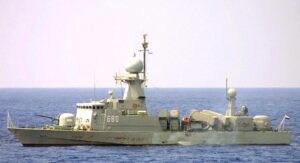
FK speedboat HETTEIN of the RAMADA class (Image: German Navy)
But that's not all: at the beginning of the 1990s, the USA handed over second-hand KNOX-class frigates, which were followed a few years later by several more. Ships of the OLIVER HAZARD PERRY class will follow and deliver new, modern SWIFTSHIPS mine defence vehicles. In 2003, five FKSpeedboats CLASS 148 and two supply vessels. Since 2006, OSPREY minehunting boats decommissioned by the US Navy have been serving alongside the old Soviet NATYA and YURKA class boats. In order to be able to hold on to the tried and trusted, used OSAs that have been decommissioned in Montenegro and Finland were purchased in 2007, mainly as spare parts donors for the company's own old boats. Modernisation is planned for the RAMADAN, which is now 30 years old.
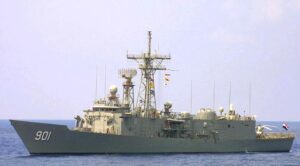
Frigate SHARM EL SHEIKH of the PERRY class (Image: German Navy)
Finally, a ten-year-old project is also gaining momentum. As early as 1999, the Egyptian Navy in the USA to build (and finance) six to eight modern, larger FK boats. They are to replace old HEGU and OKTOBER class boats from 2008 at the latest. The AMBASSADOR Mk-III design from the US shipyard Halter has been chosen. The 750-ts corvettes, which are armed with, among other things, the FK Harpoon anti-ship missile and RAM air defence system, fulfil the wishes of the Egyptian Navy, but they are so expensive that only four can be ordered. The bankruptcy of the US shipyard delayed the start of construction. It is not until 2005 (when Halter finds a new owner) that the project is revived, and in December 2009 the US Congress gives its final blessing.
In February 2011, President Hosni Mubarak, who had ruled autocratically for 30 years, was overthrown in the "Arab Spring". The first free presidential elections Egypt brought the Islamist Mohammed Morsi to power in June 2012. When he sees his mandate as a licence for an - Islamist-influenced - autocracy ("winner takes all"), the army ends his government after just one year. Army chief Abdel Fattah el-Sisi takes over and is elected as the new president in June 2014.
Following el-Sisi's coup, the USA is suspending military aid and arms exports for Egypt "on the test bench". A planned delivery of combat aircraft is cancelled, but construction of the AMBASSADOR corvettes continues. Just a few months after the coup, the first two boats are even formally handed over, but remain in the USA for the time being to complete crew training. In May 2014, they set off on a special transport ship on their journey to Egypt on. The remaining two boats are also about to be delivered.
Although the political future is very much in doubt in these troubled times, the navy can still get another, repeatedly postponed project off the ground: the renewal of its submarine component. In the final years of the Mubarak regime, the navy was still primarily looking for "bargains" on the second-hand market, focussing on decommissioned German Type 206A submarines and ex-Yugoslavian HEROJ-class submarines, among others. When these endeavours were unsuccessful, new builds were discussed. Initially, enquiries were made in China and Russia, but then a deal was struck with Germany. In November 2011 - Mubarak has since fallen - the Federal Security Council authorises the export of two TYPE 209 submarines. The media talk about conventionally diesel-electric powered (no air-independent propulsion) submarines similar to those built for South Africa a few years ago (Type 209-1400 SAN).

South African TYP 209 submarine - probably similar for Egypt (Photo: Michael Nitz)
When the (Islamist) President Morsi took office, there were initially reservations again, but these were quickly dispelled. Submarines are not suitable as a domestic political instrument of power for repressive measures against opposition sections of the population. Egyptian Population. The contracts with ThyssenKrupp Marine Systems are signed at the end of 2012 and Kiel-based HDW can begin construction. The first submarine is to be delivered in 2016. At the beginning of February 2015, the Federal Security Council authorises the subsequent planned construction of two more submarines of this type.
France is one of the first Western states to quickly return to business as usual in terms of armaments policy following the coup by army chief el-Sisi. In June 2014, the bilateral naval exercise "Cleopatra 2014" took place off the coast of Toulon - and in the same month, France ordered Egypt four 2,400-ts corvettes of the GOWIND-2500 type. The first of the corvettes, which are optimised for marginal sea operations and missions in the coastal apron, is the GOWIND-2500. Ships will be built at the French DCNS, the remaining three will then be built in Alexandria with DCNS shipyard assistance and under a technology transfer agreement. The media are talking about an option for two more units.
The armament and equipment allow operations in almost the entire spectrum of traditional naval warfare (including submarine hunting). The GOWINDs can also serve as operational platforms for commandos or be deployed in asymmetric scenarios (combating piracy/terrorism, protecting offshore installations, environmental protection, search & rescue, humanitarian aid). Incidentally, the project is being financed with the active support of Saudi Arabia, which recognises ex-General el-Sisi as a guarantor for the suppression of radical Islamism.
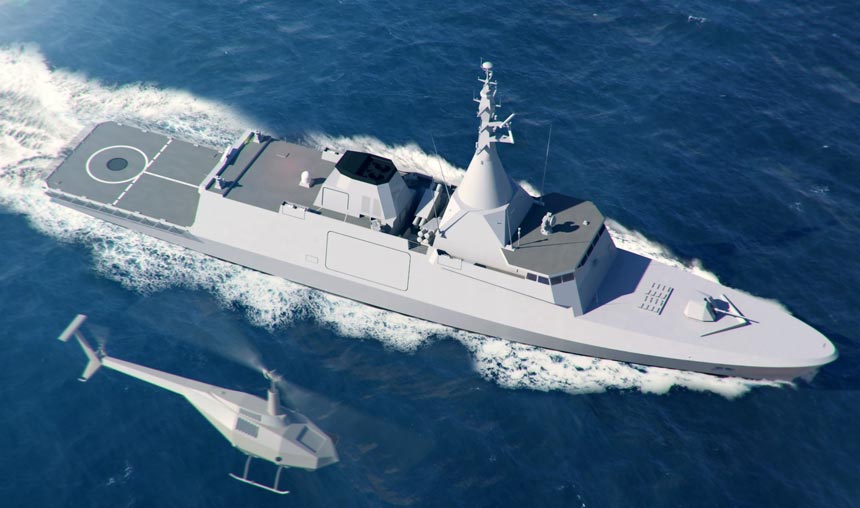
Multi-purpose corvette GOWIND 2500 (Image: DCNS)
With the GOWIND alone, the Egyptian Navy, however, is clearly not being served. They won't be commissioned for a few years, making them a good option for the future, but there is already an urgent need for at least one modern, larger combat ship. France is once again stepping into the breach. In mid-February 2015, another armaments package worth billions is signed, which also includes the delivery of a FREMM multi-purpose frigate.
The ship in question is the NORMANDIE, which was originally intended for the French Navy. Its delivery to the French Navy, which was originally planned for the end of 2014, was cancelled after the Egyptian Wishes frozen. Now manufacturer DCNS is preparing the new building for service at the Egyptian Navy, modifies some systems and equipment and trains the first crew. The frigate is to be handed over as early as June. Allegedly Egypt The company also wanted to buy a second FREMM, but despite Saudi support the money was not enough.
Summary and evaluation
With more than 100 ships on the list of warships Ships and boats as well as a workforce of almost 20,000 personnel, the Egyptian In terms of sheer numbers, the German Navy is still the strongest in the entire Arab region. The current procurement projects are certainly suitable for emphasising this claim.
Operational command is carried out directly from the naval headquarters in Ras El Tina near Alexandria. This is also where the largest naval base is located, including the frigate and submarine brigade. There are other smaller bases along the entire Mediterranean coast - from Sollum to Port Said, in the Suez Canal (Ismailia) and at its southern exit, and finally in the Red Sea near Hurghada and Safajah.
Although the navy's fleet includes ocean-going combat vessels, hardly any tasks are recognised for the navy beyond coastal waters; this is also reflected in its official mission. First of all, it is supposed to protect harbours, the coast and territorial waters as well as the entrances to the Suez Canal, which supports the national economy, and its approaches, and to fend off enemy attacks from the sea. To this end, it also has coastal defence positions with FK batteries.
It is also tasked with supporting land force operations through maritime flank protection, amphibious operations and commando operations, as well as protecting inland waterways and the Suez Canal from terrorist attacks and combating smuggling and migration by sea. For this part of its mission fulfilment, it is also operationally subordinate to the Coast Guard, which is otherwise structurally part of the border troops. There is no separate naval aviation component; air force aircraft fulfil maritime tasks when required.
Unfortunately, the operational capabilities of the Egyptian Navy falls short of the expectations of such a large fleet in terms of numbers. On the one hand, this is due to a pronounced "material diversity", a hodgepodge of the most diverse technology, which is probably unique in this form worldwide. Ex-Soviet products can be found right next to old and new Chinese, American and Western European systems, spare parts and technical manuals. The planned new additions are likely to add to the logistical nightmare (keyword: spare parts stockpiling).
There are also considerable training deficits. Even though exercises with other (western) navies are gradually increasing, the Ships and boats only have a few days at sea. With "laird-style" leadership, the team spirit among crews is not very pronounced, and the regional fragmentation from the Mediterranean to the Red Sea is not exactly favourable either.
However, the main factor is likely to be that - as in the Middle East as a whole - the navy in Egypt conceptually, but above all in terms of budget, ranks far behind the army and air force. There is little understanding of overarching maritime issues among the political and military leadership (which have been largely identical for decades), and the function of a navy is largely seen as merely supporting the land forces from the sea. As a result, its resources for new procurements, as well as for the maintenance and repair of existing units, remain significantly limited. Ultimately, it has to make do with what the army and air force "leave over".
In the future, the Egyptian navy will remain dependent on substantial aid from friendly nations. President el-Sisi has taken a clear stance in the fight against radical Islamism, which is probably only just beginning both domestically and regionally, and can certainly hope for broad support here. Relations with Israel are also more relaxed. The radical Islamic organisation Hamas, which governs Gaza and has officially joined forces with Islamist terrorist groups on the Egyptian Sinai, you have a common enemy, and true to the motto that has always characterised political relations in the Middle East, "the enemy of my enemy is my friend".
Author: Klaus Mommsen


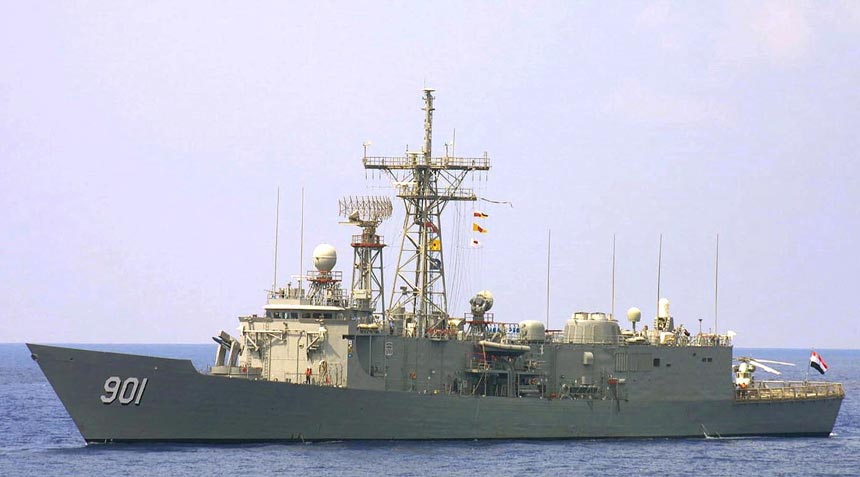








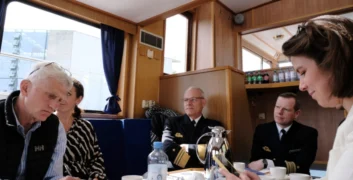
0 Kommentare